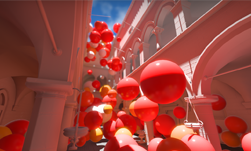HDRP is used for creating high-definition and photorealistic visuals. The render pipeline is out of Preview starting with package version 7.2.0 in 2019.3 and Unity version 2019.3.2f1 (required for real-time ray tracing). You can find more details about HDRP here, but this blog post will focus specifically on the ray-tracing features that HDRP offers.
HDRP follows physically based rendering rules, but it has limitations in its lighting processing due to the nature of the rasterization pipeline. Real-time ray tracing allows you to unlock greater visual fidelity since it doesn’t have the same visibility issues related to screen space approximation use in HDRP. It also allows you to avoid relying on pre-baking steps for lighting, which improves artists’ workflows.
There are two different uses of ray tracing in HDRP:
1. A mix of real-time ray tracing techniques and rasterization, which we call the hybrid pipeline
2. A progressive path tracer

